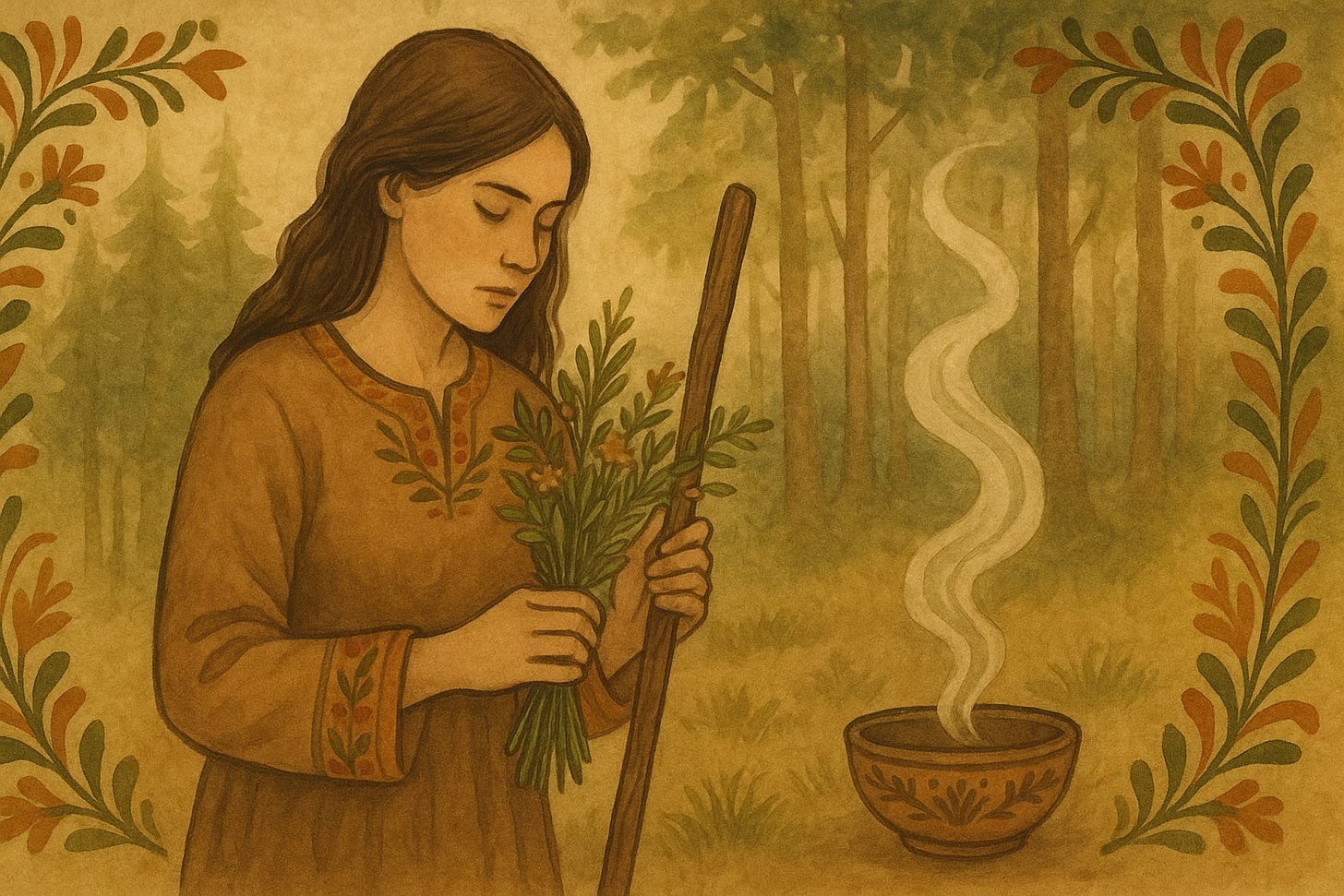North: Reclaiming Norse Folk Magic—Seiðr, Galdr, and Trolldom
Reviving my own indigenous connection to the land through Nordic animism, shamanism, and witchcraft
I’ve walked many paths—but the winds of my Northern ancestors calls me home. Not out of obligation. Not out of some myth of pure blood or heritage. But because tending to my own ancestral roots electrifies my practice. It hums in my bones.
It’s also part of my deeper work of unlearning whiteness. Before my people were conscripted into white Christian supremacy, we too were people of the land. We prayed to sun and soil. We sang to rivers. We sat with the dead. We knew that the thread of life was sacred, not separate.
That’s why I am turning toward Seiðr. Toward Galdr. Toward Trolldom. Toward the witch at the edge of the woods who speaks with spirits and sings fate into form. This is the practice of my northern ancestors—and it’s calling me.
Who Was the Völva?
The word Völva comes from vǫlr, meaning “staff” or “wand”—a reference to her ritual tool and symbol of spiritual authority.
She appears throughout the Icelandic sagas and Eddic poetry, summoned in times of crisis—war, plague, upheaval. In Völuspá (The Prophecy of the Seeress), Odin himself calls on a Völva to reveal the past, present, and future of the cosmos, including the cataclysm known as Ragnarök.
She is not clergy. Not queen. She is a witch in the truest sense—between worlds, beholden to no one, shaped by the land.
Seiðr: Trance and Thread
Seiðr is one of the oldest magical traditions in Norse culture—an ecstatic practice of fate-weaving, spirit communion, and reality-bending.
Found in sagas like Eiríks saga rauða and Laxdæla saga, Seiðr was often done in altered states: veiled, drumming, chanting, sitting on a ritual high seat (seiðhjallr). Practitioners journeyed beyond the seen world, performed healing, prophecy, soul flight, and sometimes curse work.
Freyja taught it to the gods. Odin practiced it—but was mocked, because Seiðr was considered women’s magic: wild, embodied, transgressive.
Today, Seiðr is being remembered as a living technology for trance, vision, and ancestral connection.
Galdr: Spell-Song and Rune-Chant
If Seiðr is the thread, Galdr is the sound that moves it.
From galan (“to sing” or “to enchant”), Galdr is a practice of chanting runes, reciting spell-poems, and invoking with voice and breath. It was practiced across genders, often paired with runes and poetic meter.
In Hávamál, Odin reveals 18 magical chants—spells for healing, protection, awakening, even resurrection.
Modern Galdr may include:
Rune chanting (e.g., Ansuz, Raido, Kenaz for inspired movement)
Invocation in ancestral meters like fornyrðislag
Spellcraft through poetic recitation
Sound and breath as vibrational magic
Galdr reminds us: the voice is a wand. Breath is the first spell we ever cast.
Trolldom & Troll Cunning: Folk Magic of the North
While Seiðr and Galdr often draw the spotlight, there’s another stream of northern magic that flows quietly through farmsteads, kitchens, and graveyards: Trolldom.
Trolldom is the folk magic of the Nordic peoples—practical, ancestral, and rooted in lived relationship with land and spirit. This is not priestly magic or poetic incantation. It is the spell muttered while tying a red thread. The herb bundle hung above a cradle. The whispered curse or the healing charm passed down through generations.
The word troll here doesn’t mean fairytale monster. In older usage, trollkunnig (“troll-wise”) referred to someone skilled in sorcery, usually through intimate knowledge of natural forces, hidden beings, and the in-between. Trolldom practitioners were often midwives, herbalists, bone-setters, or spirit workers. Many were Christian. Most were women. All were walking the line between seen and unseen.
Trolldom is:
Spells carved into wood and spoken over wounds
Blended traditions of pre-Christian animism and folk Christianity
Amulets made of iron, bone, or plant
Rituals of protection, healing, binding, and release
Deeply regional and oral—varying village to village, family to family
Unlike the more formal rituals of Seiðr or the chant-based structure of Galdr, Trolldom seems to resist systemization. It isn’t a doctrine, so much as what works.
Teachers and Resources
In Scandinavia (English-friendly):
Annette Høst – Co-founder of the Scandinavian Center for Shamanic Studies. Teaches Norse shamanism and Seiðr in an ethical, land-honoring, animist framework.
Samfundet Forn Sed Sverige – A registered religious community dedicated to inclusive, anti-racist Norse spirituality.
Marius at Vikingr.org – Norwegian teacher and writer on Norse myth, Seiðr, and Viking spirituality for a global audience.
Rune Hjarnø Rasmussen – Danish historian and founder of Nordic Animism. Reclaims pre-Christian spiritual worldviews as ecological, animist, and anti-colonial.
Johannes Björn Gårdbäck – Swedish practitioner raised in the Trolldom tradition by his grandmother and other elders. Author of Trolldom: Spells and Methods of the Norse Folk Magic Tradition. His work emphasizes oral tradition, folk healing, and Christian-pagan blends.
Andreas Kornevall – Swedish storyteller and ritualist. Director of the Earth Restoration Service. Teaches mythic rites, sacred land practices, and Norse animism with an ecological lens.
In North America:
Mathias Nordvig – PhD in Old Norse literature. Professor at CU Boulder. Specializes in Norse mythology, whiteness studies, and land-based cosmologies of the pre-Christian North.
Missy Johanna Rhysing – Founder of Ritualcravt. Swedish-American folk practitioner reweaving ancestral magic for modern times.
Haley Huston – Founder of The Nine Winds, a practice rooted in animism, Norse sorcery, and ancestral connection. Offers Seiðr, spirit-work, and trauma-informed ritual through online courses and in-person intensives.
Kari Tauring – Norwegian-American völva, rune singer, and teacher of Galdr, staff rhythm, and embodied ancestral Seiðr. Deeply animist, ethical, and body-based.
Cat Heath – British-American author of Elves, Witches & Gods. Teaches Norse animist magic, folk necromancy, and spirit-work rooted in Northern European traditions. Known for weaving historical sources with lived ritual.
I’ll report back as I learn more.
In spiritual solidarity,
🧿 Constant Craving ✨




